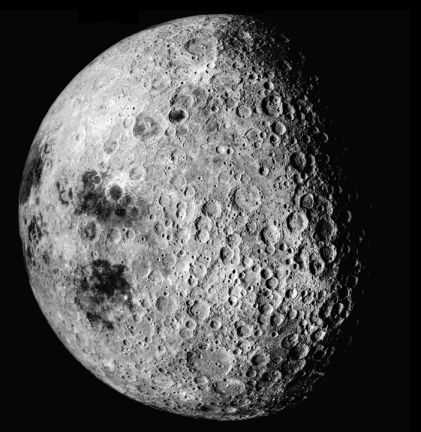THE MOON - OUR CLOSEST NEIGHBOUR

Most of the moons found in the solar system are very small in comparison to the planet they orbit. However the earth's moon is large in comparison (about one third the size of the earth) and many astronomers consider the earth-moon system to be a double planet.
The moon orbits the earth every 27.5 days and its rotation time is the same so we always see the same side of the moon facing us. The first time mankind ever got a view of the dark side of the moon was when the Luna 3 space probe sent back photos in 1959.
When looking at the moon with the unaided eye, two types of terrain can be seen. The lighter areas are the mountainous regions. These are known as the 'highlands'. The darker areas are the 'mare' regions. These are flat low lying regions. 'Mare' is the latin word for sea and at first it was thought that the darker areas of the surface were lunar oceans. They are actually large basins that filled up with lava which pushed its way to the surface 3 to 4 billion years ago.

When looking at the moon through binoculars most of the craters appear to be concentrated in the lighter areas. This is because early in its life the moon was bombarded with meteorites that were left over from the formation of the solar system. When lava flowed into the low lying regions it covered the craters in these basins. Since then the moon has been hit by relatively few large meteorites and the luna plains are not so cratered.
Since the volcanism that ended about 3 billion years ago, not much has changed on the moon's surface. Apart from the infrequent small meteorite the recent changes have been man-made. There are the craters where probes and spent rocket stages have crashed into the surface and the footprints made by the astronauts themselves.

In fact it is quite possible that these footprints could outlast any trace of mankind on earth.
| Moon Statistics
|
|---|
|
|
|---|
| Equatorial radius (km) | 1,737.4
|
|---|
| Mean distance from Earth (km) | 384,400
|
|---|
| Rotational period (days) | 27.32166
|
|---|
| Orbital period (days) | 27.32166
|
|---|
| Average length of lunar day (days) | 29.53059
|
|---|
| Mean surface temperature (day) | 107°C
|
|---|
| Mean surface temperature (night) | -153°C
|
|---|
| Maximum surface temperature | 123°C
|
|---|
| Minimum surface temperature | -233°C
|
|---|




